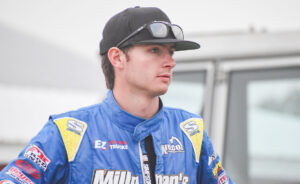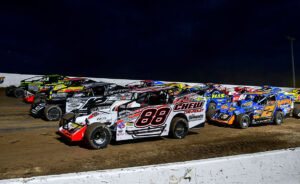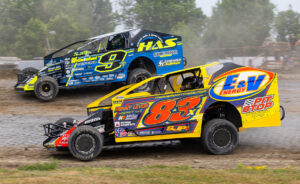The Super DIRTcar Series, the World of Outlaws Late Models, and the World of Outlaws NOS Energy Drink Sprint Cars each represent the pinnacle of professional racing for their respective divisions. While visually unique from one another, the Big Block Modified of the Super DIRTcar Series hides its secret weapon underneath the hood: the formidable, powerful, and raucous Big Block engine.
From its distinctive grunt coming out of the corner of Weedsport Speedway to the roar at the end of Lebanon Valley Speedway’s straightaways, Big Blocks turn the heads of race fans based on their earth-shaking sound alone. These unique power plants are typically retrieved from junkyard trucks and skillfully machined into highly tuned engines pushing over 800 horsepower.
Like a board-rattling NHL bodycheck or the roar of Niagara Falls, the sound must be experienced in person to be understood. Super DIRTcar Series Director Dean Reynolds shared his favorite story about the effect of the sound and the fury of the iconic engine.
“There’s no sound like a Big Block. In 2019, we went to Eldora Speedway. On the second night, we had the invitational with the NASCAR Truck Series. The NASCAR officials were up in the tower and the Trucks finished their practice. We put out 18 Super DIRTcar Series Big Block Modifieds and they made the tower shake. The NASCAR officials ran to the window to see what was making that noise.”

Today, Big Blocks are only used in a few racing divisions around the country including the Super Modifieds that soar around Oswego Speedway, when it’s in its “Steel Palace” form, as well as in pro drag racing and drifting. Their raw power and unmistakable sound make Big Blocks a continuing obsession for race fans and racers alike.
Similar to the USAC Silver Crown car, the Big Block Modified is a living legacy of American motorsports. Big Blocks harken back to the days of true Modified Stock Cars. “Jalopies” or today’s Late Models had their noses cut off, lightened, and stuffed with big engines to make what they called Modifieds whether they raced on pavement or dirt.
Big Blocks were the biggest, most powerful engines you could find. The sound you hear today is the same sound fans heard at tracks like Super DIRT Week’s New York State Fairgrounds, Reading (Fairgrounds Speedway), and Nazareth (Speedway).
Legend of the Super DIRTcar Series, and master of the Big Block Modified, Brett “The Jet” Hearn said he believes in the staying power of the engine. A prime reason he brought DIRTcar Big Block Modified sanctioning back to Orange County Fair Speedway for another historic season on the 5/8-mile dirt track.
Hearn won his third Big Block race ever at Orange County after getting his start in the Sportsman division. Despite taking to it quickly, it was still a major adjustment.
“It is so top-heavy that they are a handful to drive,” Hearn said. “We used to joke if you want to make a Big Block handle put a Small Block in it. So, there is definitely a particular skill to be able to handle the torque and horsepower.”
Hearn tallied 141 Super DIRTcar Series Feature wins during his career, plus many more weekly track races and specials. “The Jet” knows it’s not only Series racing where the Big Block performs.
“I think it’s important to the local weekend driver to aspire to make the tour and be recognized as a top Big Block Modified driver,” Hearn said. “The tour is nationally recognized so that top drivers of today are offered opportunities but there is something great about racing a Big Block Modified for a living.”

Big Blocks are not just crowd-pleasing, but they are also important to the foundation of DIRTcar in the Northeast and Canada.
“On the technical end we have stayed the course with the Big Blocks, and it’s helped the competitors knowing this is what the rules are going to be from year to year,” said Series Director Dean Reynolds. “Are Big Blocks expensive? Yes, but when racers know this is the only engine they need to get to compete across the board it helps car counts overall.”
It’s not just durability and loud noise that give Big Blocks their character. In 2025, it’s the most truly Modified part of the race car.
“Even though we have strict rules on body and suspension, it’s the engines that are really the modified part now,” Reynolds said. “You can do what you want to the engine other than mess with the cubic inches.”
Hearn saw firsthand the importance of keeping the Super DIRTcar Series pure under the hood.
“I remember in the 1990s when the rules were looser and the “Big-Small Block” began to infiltrate the Big Block division,” he said. “It was a better engine on the asphalt series we had because it’s a bit lighter. Glen Donnelly (founder of DIRT) didn’t want to have the division tainted by a mixture of Small blocks and Big Blocks. We wanted it to be known nationally as a Big Block division. It’s what gave it its uniqueness and he wanted to protect that. We are one of the only divisions in the country that runs a Big Block engine.”
Donnelly’s vision of a unified Big Block series lives on as the Super DIRTcar Series enters its next season starting Wednesday, Feb.12, at Volusia Speedway Park during the 54th Annual DIRTcar Nationals. Race fans then get the chance to experience the Big Block sound in person as the Series makes tour stops in Delaware, New Jersey, Pennsylvania, Quebec, Ontario, and New York throughout the season.
Get the entire Super DIRTcar Series schedule here and if you can’t make it to the track watch every race live on DIRTVision.





